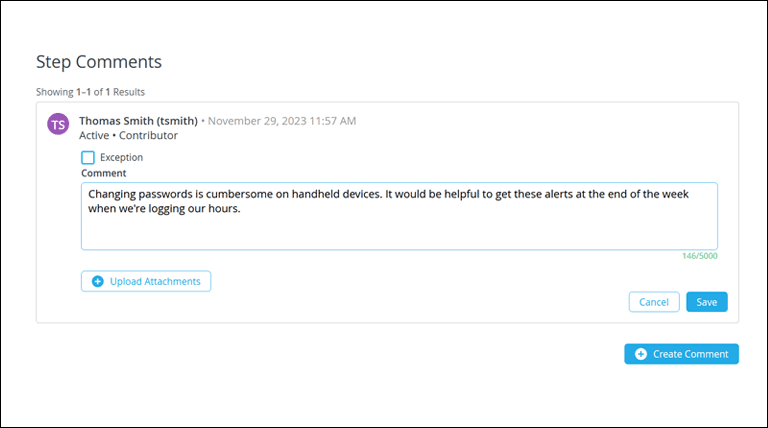Feedback – the Key to Unlocking Employee Behavior Change
That’s taking feedback from employees, not giving it to them…
- When your employees feel engaged in improving work processes, they’re more likely to follow them.
- Eliminate barriers and make it easy for your team to share feedback within their workflow.
- A constant stream of good ideas coming from your frontline teams can help identify patterns, eliminate problems, and improve process efficiency.
- Seeing change based on their feedback shows employees you’re paying attention and value their input.

If you only read the headline of this post, you probably thought we would tell you how to give feedback to employees to help change their behavior. Actually, a faster route to employee behavior change is to get them to provide feedback to you and then act on it. Employees who feel they are part of creating their work processes will take ownership of them. Your team will begin to see the process as something there to help them instead of something to control them.
You may make excellent progress improving workplace efficiencies by hiring consultants to analyze processes and remove redundancies. But some of the most helpful changes will come from the folks who do the work every day. Your team members think about their part of the process more than anyone else. They have a fundamental interest in making their work as frictionless as possible. And they have the most to lose if something goes wrong on their shift.
Despite this inherent self-interest in making improvements, people are often reluctant to come forward with their ideas. As business leaders, we own the blame here. We have not always provided clear incentives or a simple way to submit feedback. And we’re not always good at following through on the feedback we do receive.
Employees are reluctant to give feedback for lots of reasons:
- They’ve given feedback previously and nothing happened.
- They don’t realize they have anything valuable to share.
- They’ve worried about how they’ll be perceived if others don’t think their idea is a good one.
- They’re concerned about consequences if the idea doesn’t work out as they envisioned.
- They don’t see anything in it for them.
If we can overcome some of these concerns, we’ll improve our processes with a constant stream of good ideas coming in from our teams. We’ll also see more employees following our processes because they, themselves, will see the value in them.
Incentivizing Feedback

In the 1980s, Charles Masefield was a new general manager at BAE Systems,1 the massive British defense company. He was sent to Chatterton, one of the companies worst performing plants. He was certain this assignment would end his career, as the struggling factory had already ruined the previous two GMs assigned to it before him.
Masefield had been studying Japanese productivity and their practice of holding daily ‘quality circles’, where people got together in small groups and talked about problems and how things could be done better/faster/more efficiently. He began to hold these sessions at the plant for 10 minutes every day. The problem was, nobody was participating.
Speaking with some employees over a beer, he learned that the problem was motivation. Those who submitted good ideas that were implemented to solve problems earned a cash prize equivalent to $20 in today’s money. Not much of an incentive to stick your neck out with an idea. Masefield changed the incentive to a one-time 10% reward, meaning an employee could earn 10% of whatever the company saved or made from their idea. The employee would see an immediate and potentially massive reward, and the company would get an idea that would save them money year after year.
After the first prize was awarded, employees understood it was real and suggestions came pouring in. The factory went from one of the company’s worst performing, to one of its most profitable. Masefield eventually went on to become president of the company and has led several other companies since.
Masefield solved the incentive problem with cash. Money may be the first thing that comes to mind for you as well, when you think about incentives. But more recent research indicates that money may not help surface the ideas that will solve your biggest problems.2 More importantly, money may not motivate or change the behavior of all employees. This seems to be particularly true with younger generations who are clearly more motivated by incentives like contributing to a greater good.3
We’ve found one of the most motivating ways to engage employees in helping to fix our processes is to explain the benefits of our processes and the real purpose behind them.
- Our processes serve as guidelines to help us do our job with as few headaches as possible.
- If we follow the process, we’ll make less errors.
- This means less rework, less injuries, and less fixing things we’ve messed up.
- Any incremental improvements we make to the process means even less headaches.
Killing the suggestion box and making it easy to provide feedback

Have you ever used a suggestion box? Have you ever read some of the suggestions that get put into those boxes?
“All we get are a bunch of complaints and impossibly wild ideas that we couldn’t follow up on in a million years.”4
Sound familiar? It’s not because our employees don’t have good ideas, it’s because we’re not making it easy to share their most relevant ideas. When a suggestion box exists outside of workflow – even if that suggestion box is an ‘easy to use’, digital suggestion box – there are a ton of unseen hurdles in front of it.
As an employee, not only do I need to notice an opportunity to improve, I have to remember it. Then I have to remember how I’m supposed to submit the idea. I need to find the time to go through that process and hope that it wasn’t all a colossal waste of time and effort. That usually means that the only folks we hear from are those with an axe to grind.
In Acadia, we’ve made feedback super easy. All processes can be converted automatically into task lists and assigned to employees. Each task has corresponding instructions and job aids to make it easy to perform the task the right way. As employees perform their work, there is an ability to provide feedback during each step of each task.
Compiling feedback from multiple employees, will often cause patterns to emerge. Common problems can be identified as well as more efficient processes.
This is what incremental continuous improvement is all about. Those closest to the process identifying small ways to improve things and then quickly implementing and benefiting from those changes.
Following through on feedback

More granular and specific employee recommendations are often easier to approve and implement. This helps in two important ways. It brings you to process improvement and efficiency gains more quickly. It also shows your employees that you’re paying attention and you value their input.
When you implement a change in process, this creates an incredible opportunity to reinforce the value of employees sharing their ideas. Publicly draw attention to those who contributed them and make clear the rest of the team understands the value of the changes that have been made.
Everyone give Bev a high-five, she just saved you all a daily, 20-minute headache…
By publicly championing the value of improvements and the team members who contributed to them, you will prime the pump for more feedback, better ideas, and employees committed to a culture of change.
Behavior Change in Action
Employees who feel a sense of ownership of their work processes are way more likely to follow them and to recommend improvements. When their managers show they care enough to listen and make changes based on the feedback, behavior change is a likely outcome.
As an example, a large manufacturing customer was introducing Acadia into one of their plants in Montreal. The plant manager was skeptical about the willingness of his employees to use the procedural task list, much less provide feedback on the process.
That very night, after the PM had gone home for the evening, his night shift submitted feedback on multiple tasks. One of the most impactful involved a packaging machine with a worn part that was creating frequent jams. Each jam meant the machine had to be shut down, cleared and restarted, wasting both material and human hours. The employees didn’t want to have to deal with the jams, but there wasn’t a clear method to escalate the issue. So, they just cleared the jams and went on with their work.
When the manager was made aware of the issue, he was able to quickly work out a solution. It’s unclear when or if the manager would have learned about the issue otherwise.
Seeing quick changes made it clear to the team that their feedback wasn’t landing on deaf ears and the plant continues to see process improvement suggestions come in from every team.
Sometimes the quickest route to employee behavior change is to change ourselves.
Use incentives that are good for your business, but also show you care about your employees. Put them at the center of your improvement process. Make it easy for them to get feedback to you and encourage feedback to be hyper-focused. When a good idea comes through, implement it! And make sure your team knows who was responsible and how they will all benefit.
Sources:
1. Charles Masefield on humility and productivity
2. Your Employees Have All the Creativity You Need. Let Them Prove It.
3. Need to Keep Gen Z Workers Happy? Hire a ‘Generational Consultant’
Ready to crush your goals?
"*" indicates required fields


